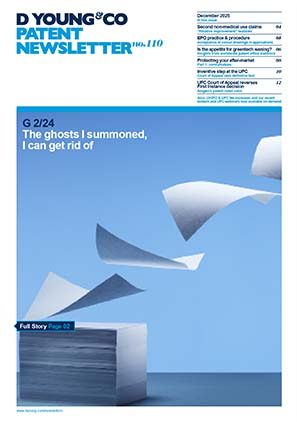Unified Patent Court: added subject matter
The European Patent Office (EPO) is renowned for its strict test for added subject matter, but will the Unified Patent Court (UPC) follow in the EPO’s footsteps, or carve its own path? We review recent UPC decisions relating to added subject matter, with early signs that the UPC is open to a slightly more relaxed approach.
The EPO’s “gold standard” approach
Added subject matter is governed by Article 123(2) EPC, which states that a European patent application may not be amended such that it contains subject matter extending beyond the disclosure of the application as originally filed.
The “gold standard” test is applied when dealing with Article 123(2) EPC, in which the EPO asks whether the skilled person is presented with information which is directly and unambiguously derivable from the application as filed when account is taken of matter which is implicit to a person skilled in the art (G 2/10).
In practice, this test often becomes a near literal assessment of the language used in the application as originally filed. Such a rigid approach has seen European patents revoked for as little as a missing comma (T 1127/16 and T 1473/19).
The EPO’s approach to intermediate generalisations
The situation is complicated when the claims are amended to include a feature isolated from a particular embodiment, or to omit a feature from a particular embodiment. Thus, one or more features in the claim is only described in the application documents in combination with one or more other features omitted from the claim.
In these scenarios, the EPO explores whether there is a structural and functional relationship between the isolated (or omitted) feature and the other features in the embodiment. The EPO first determines whether or not the feature is inextricably linked to the other features of the embodiment, and then whether the overall disclosure of the application justifies the isolation of the feature and its introduction to (or omission from) the claims (Guidelines for Examination H-V 3.2.1).
An amendment failing this test is judged to be an unallowable intermediate generalisation, contravening Article 123(2) EPC.
Abbott v Sibio: landmark cases for added subject matter at the UPC
In Abbott v Sibio (UPC_CFI_131/2024), the UPC’s Hague Local Division explicitly applied the EPO’s “gold standard” test and denied Abbott a preliminary injunction on the basis that claim 1 of EP3831283 likely contained an unallowable intermediate generalisation.
However, the UPC’s Court of Appeal overturned the Hague Local Division’s ruling and granted Abbott a preliminary injunction, taking a somewhat more holistic approach to the assessment of added subject matter (UPC_CoA_382/2024).
The decisions of the Hague Local Division and the UPC Court of Appeal hinged on whether the omission from claim 1 of an elastomeric seal in the recess of the base portion of the claimed glucose-monitoring device amounted to an intermediate generalisation. Abbott argued that the elastomeric seal was not an essential feature, evidenced by its absence from some of the drawings in the patent. Sibio argued that the elastomeric seal was consistently disclosed in combination with the recess.
At first instance, the Hague Local Division held that a structural and functional relationship existed between the elastomeric seal and the recess. Therefore, the absence of an elastomeric seal in claim 1 was held to be an unallowable intermediate generalisation.
On appeal, the Court of Appeal characterised the key test as “what the skilled person would derive directly and unambiguously using his common general knowledge and seen objectively and relative to the date of filing, from the whole of the application as filed, whereby implicitly disclosed subject matter, i.e. matter that is a clear and unambiguous consequence of what is explicitly mentioned, shall also be considered as part of its content”. Although the general principles laid out by the UPC Court of Appeal are consistent with the EPO’s “gold standard” approach, the UPC Court of Appeal placed an increased emphasis on accounting for implicitly disclosed subject matter.
Applying this standard, the UPC Court of Appeal held that claim 1 did not contain an unallowable intermediate generalisation. Importantly, the Court of Appeal did not find that the two features were separable based upon the content of the application. Instead, the Court of Appeal noted that no guidance was provided in the application regarding the advantages and disadvantages of any particular type of seal. Thus, the Court of Appeal was satisfied that, when looking to the function of the elastomeric sealing, the skilled person “would not consider the use of an elastomeric sealing to be necessary for achieving the overall aim and effect of the invention”.
Further application of the Abbott v Sibio approach
The decision in Abbott v Sibio was applied directly by the Paris Local Division in Hurom v NUC (UPC_CFI_163/2024), which concerned Hurom’s EP3155936, relating to a juicing machine.
A key argument presented by NUC was that dependent claim 3 as originally filed required a first shaft gear to be “interposed between” the driving shaft and power connector of the claimed juice squeezing module. However, during examination, dependent claim 3 had been amended such that the driving shaft, power connector and first shaft gear are merely “connected to each other”. This language was inserted into claim 1 of the main request during UPC proceedings.
There was no verbatim basis for the “connected” language in the application as filed, and NUC argued that it thus extended beyond the content of the application as originally filed. However, the Paris Local Division noted two embodiments in the description; one using the original “interposed” language, and another which required the first shaft gear to be “engaged” with the power connector.
The Paris Local Division considered that the “connected” language of amended claim 1 was an “appropriate concept that covers both embodiments”. The Paris Local Division cited a further paragraph in the description which noted that the structure of the brush rotating means (which contained the first shaft gear) could be “freely varied”. As such, the Paris Local Division held that the skilled person should not interpret the configuration of the first shaft gear too literally and that the claim did not contain added subject matter.
Conclusions
Over the last two years, several first instance decisions at the UPC have applied the EPO’s “gold standard” test for added subject matter (for example, ORD_598459/2023, ORD_598482/2023, ORD_598564/2023 and UPC_CFI_131/2024). This led to the expectation that this test would become standard at the UPC. Indeed, in its first consideration of added matter, the UPC Court of Appeal’s approach appears to be broadly consistent with that of the EPO.
However, the UPC Court of Appeal now appears to be more willing to consider what the skilled person would understand to be implied from the original disclosure as a whole, in particular in view of the overall aim and effect of the invention.
In our view, the Paris Local Divison’s decision in NUC v Hurom contrasts with the way in which the EPO likely would have assessed the added subject matter objections. In applying the “gold standard”, the EPO Opposition Division and Board of Appeal can often take a harsh stance on amendments not based on verbatim language from the original claims or description.
However, the EPO Board of Appeal appears keen to show that the UPC and EPO are aligned on added subject matter. In T 1535/23 the EPO Board of Appeal concluded that the omission of a feature from claim 1 of the patent in suit amounted to an intermediate generalisation. Interestingly, in its decision, the EPO Board of Appeal addressed the UPC Court of Appeal’s approach in Abbot v Sibio directly, noting that the approaches were highly dependent on the facts of the respective cases and therefore were not conflicting.
It remains to be seen how the UPC’s emerging approach will be interpreted in other added-subject-matter disputes. For example, will it be easier at the UPC for patentees to justify making selections from separate lists? Furthermore, given the willingness of the UPC Court of Appeal to place claim amendments in the context of the wider description, will there be an increase in the importance of catch-all, “boilerplate” language noting that features from any one embodiment may be combined with features of another embodiment?
The UPC Court of Appeal’s emphasis on taking into account the whole content of the application as filed is consistent with the claim interpretation principles established in NanoString v 10x Genomics, where the Court of Appeal held that the description and drawings must always be used. This case continues to loom large over the burgeoning UPC case law, being cited in almost every substantive decision, and serves as a reminder of the influence of the Court of Appeal in setting standard practice at the UPC for interpreting the EPC. Whether the recent Court of Appeal decision on added matter has a similar effect, such that a more lenient approach than the EPO’s “gold standard” test becomes the standard at the UPC, remains to be seen.
Case details at a glance
Decision level: Hague Local Division
Parties: Umedwings Netherlands BV, Sibio Technology Limited v Abbott Diabetes Care Inc
Citation: UPC_CFI_131/2024
Date: 19 June 2025
Decision: dycip.com/upc-cfi-131-2024
Decision level: Court of Appeal
Parties: Abbott Diabetes Care Inc v Sibio Technology Limited, Umedwings Netherlands BV
Citation: UPC_CoA_382/2024
Date: 14 February 2025
Decision: dycip.com/upc-coa-282-2024
Decision level: Paris Local Division
Parties: Hurom Co Ltd v NUC Electronics Europe GmbH, NUC Electronics Co Ltd, Warmcook
Citation: UPC_CFI_163/2024
Date: 23 May 2025
Decision: dycip.com/upc-cfi-163-2024
Decision level: Düsseldorf Local Division
Parties: Seoul Viosys Co Ltd v expert e-Commerce GmbH, expert klein GmbH
Citation: ORD_598459/2023
Date: 10 October 2024
Decision: dycip.com/upc-ord-598459-2023
Decision level: Paris Central Division
Parties: NJOY Netherlands BV v Juul Labs Inc
Citation: ORD_598482/2023
Date: 5 November 2024
Decision: dycip.com/upc-ord-598482-2024
Decision level: Paris Central Division
Parties: NJOY Netherlands BV v Juul Labs Inc
Citation: ORD_598564/2023
Date: 17 January 2025
Decision: dycip.com/upc-ord-598564-2023



